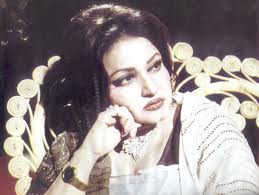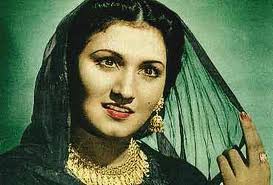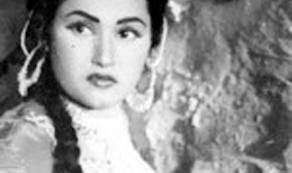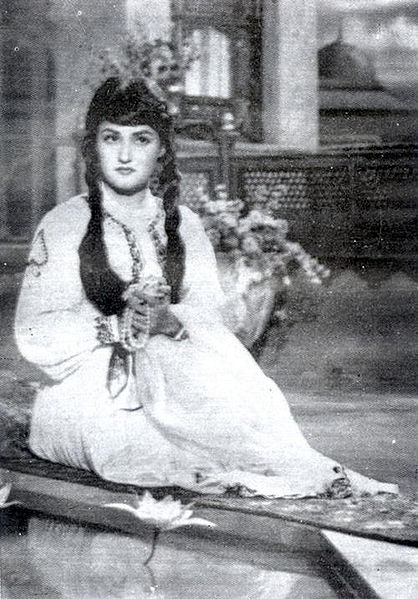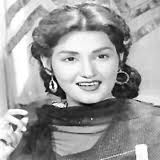Noor Jahan, singing star
This is a collection of articles archived for the excellence of their content. Readers will be able to edit existing articles and post new articles directly |
Contents |
Noor Jahan, singing star
Noor Jehan
Noor Jehan was the adopted stage name for Allah Wasai. She was born on September 21, 1926 in Kasur, British India (now Pakistan). She is renowned as one of the most melodious singers of her time in the Indian subcontinent and was honoured as "Mallika-e-Tarranum", which in English means Queen of Melody. Urdu-speaking Pakistanis respectfully refer to her ‘Madam Noor Jehan,’ obviously unaware of what that means.
Early life
She was born in a family of musicians and was encouraged by her parents to follow in their musical footsteps and become a singer. However, she was more interested in acting in films and her works graced the earliest Pakistani films. She holds an astonishing record of 10,000 songs to her singing credits in various languages of Pakistan like Urdu, Punjabi and Sindhi languages. She was the first female Pakistani film director. Sonya Jehan is her granddaughter, who is also an actress currently working in Bollywood.
Noor Jehan was one of the eleven children of professional musicians Madad Ali and Fateh Bibi. Her family often performed at theatres; although only Wasai`s eldest sisters went on to pursue a career in acting. Two of her sisters, Eidan Bai and Haider Bandi, had been successful actors at the rural Taka Theatre in Lahore.
Career
Noor Jehan started singing at the age of five or six year`s old and showed varied styles, including traditional folk and popular theatre. Realizing her potential for singing, she was sent her to receive early training in classical singing under Ustad Bade Ghulam Ali Khan who was also a native of Kasur. There, she was instructed in the traditions of the Patiala Gharana of Hindustani classical music and the classical forms of thumri, dhrupad and khayal. The Punjabi musician Ghulam Ahmed Chishti noted Wasai only at the age of nine and composed some ghazals, naats and folk songs for her to perform. However, she was more interested in acting or playback singing.
Eventually her family shifted to Calcutta, (Kolkata) with the expectation to develop the movie careers of Wasai and her sisters. During their stay in Calcutta, the renowned singer Mukhtar Begum, encouraged Wasai and her two older sisters to join film and also recommended them to various producers. It was in Calcutta that Wasai received the stage name Baby Noor Jehan. Her older sisters were offered jobs with one of the Seth Sukh Karnani companies, Indira Movietone and they went on to be known as the Punjab Mail. Jehan later adopted Mukhtar Begum`s style of performance and sari attire.
Career as an Actress
In 1935, K.D. Mehra directed Pind di Kudhi and Noor Jehan acted along with her sisters in this film. Later, she also acted in films like Missar Ka Sitara (1936), Heer-Sayyal (1937) and others. She then recorded her first song for Dalsukh M. Pancholi`s movie Gul Bakavli, titled Shala Jawaniyan Mane.
In 1942, she played the main lead opposite Pran. Khandaan`s success compelled her to shift to Bombay, where she shared melodies with Shanta Apte in Duhai (1943). It was in this film that Noor Jehan lent her voice for the second time to actress named Husn Bano. In 1945, Jehan player the lead role in the movie Badi Maa alongside Lata Mangeshkar and Asha Bhosle. In 1945, she sung a Qawwali with Zohrabai Ambalewali "Aahen Na Bhareen Shikave Na Kiye", which was the first ever Qawwali recorded in female voices in subcontinent films. Mirza Sahibaan (1947), which starred Prithviraj Kapoor`s brother Trilok Kapoor, was the last film of Noor Jehan`s in India.
Career as a Singer
Noor Jehan sang 127 songs in Indian films alone and she made 69 talking films from 1932 to 1947. Fifty-five of Noor Jehan`s films were made in Bombay (Mumbai), eight in Calcutta, five in Lahore and one in Rangoon, Burma. After Pakistan gained Independence in 1947, Jehan decided to move to Pakistan along with her husband Rizvi. She also made films in Pakistan, including Chanwey (1951), Dopatta (1952), Mirza Ghalib (1961) and so on. Noor Jehan made 14 films in Pakistan, four in Punjabi and ten in Urdu.
Awards and Honours
She has the credit of singing 10,000 songs in various languages of India and Pakistan including Urdu, Hindi, Punjabi and Sindhi languages
Noor Jehan received many awards, including with the highest Pakistani honour, Tamgha-e-Imtiaz (The Pride of Performance) in 1966.
On December 23, 2000, Noor Jehan died from heart failure. Her funeral was arranged at Jamia Masjid Sultan, Karachi and she was buried at the Gizri Graveyard near the Saudi Consulate in Karachi.
Filmography
Year Film
1939 Gul Bakavli, Imandaar, Payam-e-Haq
1940 Sajni, Yamla Jat
1941 Chaudhry, Red Signal, Umeed, Susral
1942 Chandani, Dheeraj, Faryad, Khaandan
1943 Nadaan, Duhai, Naukar
1944 Lal Haveli, Dost, Zeenat
1945 Zeenat, Gaon ki Gori, Badi Maa, Bhai Jaan
1946 Anmol Ghad, Dil, Humjoli, Sofia, Jadoogar, Maharana Pratab
1947 Mirza Sahibaan, Jugnu, Abida, Mirabai
1951 Chanwey
1952 Dopatta
1953 Gulnar, Anarkali
1955 Patey Khan,
1956 Lakht-e-Jigar, Intezar
1959 Nooran
1958 Chhoomantar, Anarkali
1959 Neend, Pardaisan, Koel
1961 Mirza Ghalib
Popular Songs of Noor Jehan
Music Faryal Aslam
While talking about popular songs of Noor Jehan, one can find a big collection with her melodious, sweet voice. The name of Malika-e-Tarannum Noor Jehan can never be forgotten by any Pakistani as she ruled the hearts of people for quite many years. She has been one of the biggest names in the music and film industry of Indo-Pak sub-continent from where she moved to Pakistan inspiring the world with her great talent for acting and singing both.
Noor Jehan was an expert not only in singing different types of songs but was also a great actress of her time. She began singing at the age of six and acted in many films before partition. After partition, Noor Jehan kept acting in films till 1963 and afterwards, paid full attention to music and singing till the end.
During the Indo-Pak war of 1965, Noor Jehan sang patriotic songs to keep the courage and valor alive in our army and public.
“Ay Puttar Hattan Te Nai Wikday” was one of the most popular songs in the times of 1965 war. The song was broadcasted through radio and television and our soldiers took help from these songs of Noor Jehan to keep their blood warm and morale high.
“Mein Teray Sang Kaisey Chalun Sajna” is a blend of Noor Jehan’s beautiful voice, great lyrics and great composition. The slow rhythmic music and great singing by Noor Jehan has made the song an unforgettable one.
“Chandni Raatein” is an evergreen song of Malika-e-Tarannum Noor Jehan which will remain fresh in minds of people forever. The music of this song was given by Feroz Nizami and Noor Jehan again showed her great talent of singing in this song.
“Sanu Nehar Walay Pull Te Bula Ke” is all times hit and people enjoy listening to this one too.
Noor Jehan: musical landmarks
Jewels in the Queen’s crown
By Dr. Zia Mutaher
Dec 23 observes the seventh death anniversary of the late singing legend Malika-i-Tarannum Noor Jehan, who singlehandedly lay claim to the genres of acting and playback singing in the cinema of the subcontinent. Here, as Images pays homage to her immortal memory, we also trace her rise to fame and repeated successes with the musical landmarks of her illustrious career.
1930s — Lang aaja pattan channa da o’yaar
Film: Sheila alias Pind Di Kurri (1935)
When the nine-year-old Allah Wasai from Kasur stood to sing her first film song for British India’s first Punjabi talkie in Calcutta, little did know that re-christened as Baby Noor Jehan, she would be proclaimed Malika-i-Tarannum and go on to reign over the stage of South Asian music for the next six decades.
1940s — Aaj ki raat, saaz-i-dil-i-purdard na chaerr
Film: Jugnu (1947)
Noor Jehan broke the silence of the night with this enchanting song, as she looked out from tearful eyes from the other end of a slow-moving boat. Never before had the moon or the flowing stream ever witnessed this intensity of human emotion expressed in such a surreal manner.
Having played child roles in Punjabi movies in Calcutta and Lahore, Khandan — an Urdu classic directed by Shaukat Hussain Rizvi in Lahore (1942) — was her first movie as a full-fledged heroine. The song Tu kaun si badli mein, composed by Master Ghulam Haider, changed the very concept of Indian film music.
But it was in Bombay that she accomplished her first hat-trick with the success of films such as Zeenat (1945), Anmol Ghari (1946) and Jugnu. The song from Zeenat, Bulbuloon mat ro yehan conferred upon her the title of Malika-i-Tarannum — Queen of Melody.
The duets of Anmol Ghari and Jugnu that she sang alongside Surinder Nath and Muhammad Rafi were on the lips of millions across the subcontinent — Awaaz de kahan hai and Yehan badla wafa ka.
With the success of this Noor Jehan-Dilip Kumar starrer, the then 21-year-old singer-actress turned into the most sought after female artiste in the studios of then Bombay. But the political drama being played on the streets outside forced her to move back to Lahore, alongside her director husband and two-year-old son. Many must have seen her departure then as the beginning of her end.
1950s — Chand hansey, dunya basey, roey mera pyar
Film: Intezar (1956)
After the blind village girl rendered this melodious tragedy on a moonlit night, nothing could come in Noor Jehan’s way to fame — neither the socio-political upheaval of 1947 nor the teething problems of Pakistans fledgling movie industry, and not even her marital discord with the director Rizvi.
In the Lahore of the 1950s, Noor Jehan rose like a phoenix from the ashes. Film buffs on both sides of the Wagah Border were thrilled to see her first dancing to the teasing tune of Mundia Sialkotia in Chan Ve (1951), then appearing all sleepless and sombre on a starry night, crooning Chandni raatein in Dupatta (1952). And now, it was the village girl in Intezar piercing the darkness of her blinded world with heart-broken melodies penned by poet Qateel Shifai and composed by music wizard Khwaja Khursheed Anwer. The crooner and the composer re-created the Intezar magic in Ghoonghat, Koel and ultimately in Heer Ranjha.
________________________________________ The song Tu kaun si badli mein, composed by Master Ghulam Haider for the film Khandan, changed the very concept of Indian film music. But it was in Bombay that Noor Jehan accomplished her first hat-trick with the success of films such as Zeenat, Anmol Ghari and Jugnu. The song from Zeenat, Bulbulo mat ro yehan conferred upon her the title of Malika-i-Tarannum — Queen of Melody. The duets of Anmol Ghari and Jugnu that she sang alongside Surinder Nath and M. Rafi were on the lips of millionsacross the subcontinent. ________________________________________
Sagar roaey, Lehrein shor machaaein
Film: Koel (1959)
It was in Koel that the Queen appeared her glamorous best, draped in a black sari and wailing in front of the sea waves, crying out for her lost beloved. But immediately after its resounding success, she announced her decision to quit acting. Having now married the young actor Ejaz Durrani, she confined herself to playback singing.If her detractors gloated at the thought of her calling it a day, the smiles were soon wiped off their faces with Madam Noor Jehan delivering non-stop melodies for three successive generations of Pakistani film heroines.
1960s — Raseelay more rassiya najaria mila
Film: Moseeqar (1962)
The innocent-faced Sabiha Khanum moved her feet to the thumping rhythm of the classical playback, with flowers in her hair and kohl in her eyes, setting the tone for a glorious ’60s.
Rahon pe tari main nazrein jamaey
Film: Ghoongat (1962)
A tall and slender Nayyar Sultana draped in a white sari wandered in a misty wilderness, lamenting Koi na jaane kab aaye.
Mun Mundir ke devta, rakho laaj hamari
Film: Lakhoon Mein Eik (1967)
Shamim Ara chanted this bhajan as she swayed in front of the deity with diyas in her hands and a bindiya on her forehead. The singer’s voice, having evolved with age, sounded mature and went well with Shamim Ara’s sobre performance.
Mujh se pehli si mohabbat
Faiz Ahmed Faiz’s magnum opus
It was her golden voice after all that had brought to life the tragic beauty of Faiz’s subtle verse. Inspired by her faithful rendition, he gifted his magnum opus to the vocalist par excellence.
Ae watan ke sajeele jawaano and Ae Puttar hattan te naen vikde
In middle-aged motherhood, she sang these anthems with all her heart and soul, for the sons of the soil fighting the 1965 war. As they returned from the battlefield claiming victory for their motherland, Madam Noor Jehan was granted the status of a national hero.
1970s — Sunn wanjli di mithri taan ve
Film: Heer Ranjha (1970)
The gazelle-eyed dancer-actress Firdaus danced to the tune of the amorous Punjabi melody and straight into the heart of her on screen Ranjha (Ejaz Durrani), who happened to be the real-life husband of the playback crooner. The two not knowing then the consequence of this bare betrayal, both Firdaus and Ejaz were to end up soon in dark oblivion, as was made sure by the hand of the shrewd singer.
Jo bacha tha woh lutane ke liye aaye hain
Film: Umrao Jan Ada (1972)
Forced against her will, Rani dressed up in black and silver and danced, struggling to set herself free of her stifling ankle-bells. At last, compelled by the striking notes of the proverbial song, they broke loose and fell off her feet in a clamour. Proclaiming her freedom, she sang in ecstasy: Ab meri rah mein taqdeer nahin; Paon mein ab koi zanjeer nahin, koi zanjeer nahin!
After having being strained to the highest notes, Madame Noor Jehan’s voice no more sounded as fresh as that of her younger rivals. But then who else could convey, and as astutely, the anguish of a woman struggling to defy her exploitation. Noor Jehan had done it before and she did it again in Pakistans Umrao Jan Ada and Naag Muni (1972).
1980s and ’90s — Jhanjharia pehna do, bindya ve chamka do
Film: Sher Khan (1981)
Anjuman, the doyenne of the Punjabi cinema of the 1980s, rode on a horse carriage holding the reins and pleading with the dancing damsels on the way to lead her to the man of her dreams — the lion-hearted Sultan Rahi, of course!
Ki dum da bharosa yaar, dum aave na aave
Film: Sakhi Badshah (1997)
With Anjuman’s career on the decline, it was now Saima’s turn to seduce the eternally angry-looking Sultan Rahi. Swaying to the tune of the heartrending number, Saima wouldn’t have known that this was to be the Melody Queen’s swan song.
Aandhi chali to naqsh-i-kaf-i-pa, nahin mila
PTV’s Tarannum
In the mid-80s and then again in the early ’90s, she appeared on the mini-screen for PTV’s musical Tarannum, decked up in glittering diamonds and shimmering silks, and with rejuvenated vocals rendered a whole new repertoire of Pakistan’s poetic best — from Bulleh Shah’s kalam to the ghazals of Mustafa Zaidi and Nasir Kazmi — adding to the jewels in her crown.
Kahan tak suno gay, kahan tak sunaoon
Film: Anarkali (1958)
Seven years after her demise, one wonders which one of her songs pleased the Almighty, so that he blessed her in life with His very best. And when it came to the final call, he chose for her the holiest of His holy nights, when the highway to heaven is said to be paved straight for the chosen traveller.
Was it the innocent plea from the film Anarkali:
Huzoor aap ki ik jahan per nazar hai;
Nigah-i-karam se mujh ko yeh darr hai;
Zamane ki nazroon mein kahin aa na jaon;
Kahan tak suno gay,
kahan tak sunaoon;
Hazaron hi shikway hain, mein kya kyabataoon.
Noor Jehan: Memoirs of a die-hard fan
By Zia Gurchani
Divorcing two husbands in a row, befriending the then President of Pakistan, surrendering a studio worth a fortune to get her daughter back and standing up to tyrants and those who opposed her, demands more than just a singing voice. It requires determination. That is what her character was: defiant.
Long after she is physically dead, Madam Noor Jehan refuses to fade away. Her voice lives on with an evergreen repertoire; she also steals the conversation even today, whether revered and reviled, glorified or belittled. In the starchy movie-making world of pleasant but predictable singers/actresses, Noor Jehan remains a trailblazing original. She spent her 74 years standing trial to an elite fraternity of wannabes, nobodies and absolute nobodies. The eulogies poured in when she died so did vile attacks on her personal life.
A respected English monthly printed an article on her which was crude and offensive in totality. The concerned editor obviously had not even bothered to take out derogatory terms such as ‘dead elephant’ that had been used to describe the accomplished singer and actress. The legend that was Malika-i-Tarranum for the subcontinent was ripped apart by her own country’s pseudo-intelligentsia after her death. The deceased are usually referred to with reverence in civilised societies, yet here was a man of letters executing cerebral emptiness. When I wrote a letter of protest to the editor, he did not even bother to respond.
While unsolicited members of the mundane masses played judge and jury, unknown dubious writers made quick money off Noor Jehan’s death by hastily putting slanderous articles in book form. One book, Gaanon Aur Gunahon ki Malika (The Queen of Songs and Sins) had a cheaply sketched wine bottle with two glasses on her photo.
As if she cared.
It is said that once a woman caught in adultery was dragged to Jesus Christ for judgment. Every mob member carried a brick or stone to pelt the woman to death. The crowd roared for permission, but Jesus remained quiet. When the crowd became uncontrollable, Jesus said calmly, “let him who has never sinned cast the first stone.”
Point made, I hope.
Madam probably would have fumed for a while then giggled at the pettiness. She loved laughing and mimicking people and their accents. She laughed at her own jokes. At times convulsed with anger, she would lambast someone privately and suddenly start giggling at her own colourful remarks. It was infectious; one couldn’t help but join her.
Used to life’s highs and lows, Madam had seen the best of professional life and the worst at a personal level. Yet she was neither arrogant nor bitter. She took life in her stride. Even court battles were embedded in her lifestyle from as early as the age of 14, when she abandoned her parents for the love of Shaukat Hussain Rizvi and eloped with him to present-day Mumbai (then Bombay). Her family sued them both because by then Noor Jehan, the star of subcontinent, was amassing wealth both as a famous singer and a heroine.
In 1953, a woman filed a petition in a Lahore court and alleged that Noor Jehan had slapped and beaten her up. When the court summoned her, she appealed through her lawyers she should be exempted from appearing in court since she was a purdah-observing lady and could not appear in public. Even Rizvi, the man she married for love, fought court battles with her over property. She traded Shahnoor Studios for custody of daughter Zille Huma. Half-a-century later, the courts were still sorting out claims to her immense wealth. ________________________________________
Every person will write history differently where Noor Jehan is concerned, but the ultimate tribute to the Melody Queen is being paid by Oxford University Press. They are including Malika-i-Tarranum in their upcoming edition of ‘Oxford Companion to Pakistan History’. It is certainly commendable because Noor Jehan’s place in Pakistan’s history is undisputed ________________________________________
After Noor Jehan quit acting in 1960 and took up playback singing full-time, she sang for more than six generations of actresses. Sabiha Khanum, Bahar Begum, Neelo, Shamim Ara, Zeba, Rani, Deeba, Nisho, Naghma, Saloni, Aasiya, Sangeeta, Shabnam, Babra Sharif, Anjuman, Gori, Neeli, Reema, Saima and the woman who broke up Noor Jehan’s marriage to film actor and heartthrob Ejaz, Firdaus, owe some of their memorable screen moments to Madam’s voice. All these actresses who lip-synced to her voice, ravaged by time faded into oblivion while still alive. But Noor Jehan stood out even among young girls who were her granddaughters’ age, and at age 70 could light up the screen with her presence. And that was when she was alive. After she died, her photographs, songs and anecdotes have become collector’s items. A plethora of new singers plundered her repertoire, gender no bar, and helped themselves to her hit songs and of course, guaranteed success.
Innovative, original and a born leader who invested in human relationships, in a society where people take themselves far too seriously or insist upon being labelled a ‘celebrity’, she knew who she was and had the gift of making other people feel important. She knew a million people but everyone felt that he or she was the closest to her. Even those who played the tabla or harmonium for her felt important around her because she was never condescending towards them but pretended she would be lost without them.
There were two sides to her: when she was good she was a delight, when she took people on she held her ground and brought them down on their knees — ex-husbands included. When she abandoned Rizvi, she reinvented herself in a way that left him thwarted, frustrated and angry. He wrote a book, Noor Jehan ki Kahani, Meri Zabani, in which he alleges that his celebrity ex-wife had affairs right under his nose. He fumed and sizzled but couldn’t abandon her until she walked out on him. Noor Jehan, famous for barracks language, apparently gave a taste of it to Rizvi also.
In India and later on in Pakistan, cinephiles adored her; men gave her stares and being from a world of liberated passions, she flirted right back. Rizvi may have been intellectually rigorous but Noor Jehan, who entered showbiz literally as a child, was the ultimate dominatrix with calamitous magic. When Ejaz married her, he enjoyed Madam’s cash and comforts openly and Firdaus’ bewitching beauty clandestinely. It devastated Madam. She exercised her ultimate resolve: caused their downfalls. She divorced Ejaz and refused to sing for any film that had Firdaus in the lead. She told producers it was either her or the other woman. The producers stopped signing Firdaus.
Madam Noor Jehan never claimed to have mastered singing by herself; she always insisted Allah had blessed her in a special way, which was true. Today, on her death anniversary, TV channels air special transmissions about her, artistes sing her famous ditties and media people flock to the events; all for a woman who died six years ago to this day.
Every person will write history differently where Noor Jehan is concerned, but the ultimate tribute to the Melody Queen is being paid by Oxford University Press. They are including Malika-i-Tarranum in their upcoming edition of Oxford Companion to Pakistan History. It is certainly commendable because Noor Jehan’s place in Pakistan’s history is undisputed.
